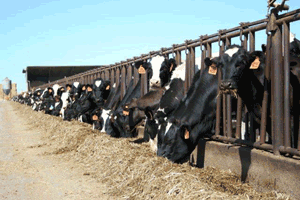
 Over the last 10 years there has been a big emphasis put on growing heifer calves faster and better in order to maximize performance and health of the animal over its lifetime. On a positive note, the acceptance of this idea has grown amongst dairy producers. However, one negative thing that has come from this is that these bigger heifers are not being bred early enough in many situations to take full advantage of the more aggressive calf growth, says Jason Leonard, calf and heifer specialist with Land O'Lakes Purina Feed.
Over the last 10 years there has been a big emphasis put on growing heifer calves faster and better in order to maximize performance and health of the animal over its lifetime. On a positive note, the acceptance of this idea has grown amongst dairy producers. However, one negative thing that has come from this is that these bigger heifers are not being bred early enough in many situations to take full advantage of the more aggressive calf growth, says Jason Leonard, calf and heifer specialist with Land O'Lakes Purina Feed. Leonard says that many heifers are still being bred at the same age as before even though they could easily be bred two to three months sooner based on size. A few problems that can result from heifers being bred too late are increased metabolic problems at calving such as ketosis, lower milk production and wasted money on feeding the heifers. Breeding based on size of the heifer could help eliminate these types of problems. The following are some size benchmarks to consider:
- Start by getting an average weight on the mature (third plus lactation) animals in your herd. Heifers can be bred when they weigh 55 percent of the mature herd size.
- Wither height of the heifers should also be at least 49 inches tall (Holsteins) to insure proper frame.
- Heifers should weigh around 85 percent of mature herd size after they deliver the calf and reach at least 53 to 54 inches tall (Holsteins) at the withers.
These breeding benchmark numbers can typically be hit by 13 to 15 months of age on most farms which would allow the heifers to calve at 22 to 24 months of age when bred by size. Leonard explains that some very well managed farms may hit these targets earlier but breeding less than 13 months of age is something that needs to be given proper thought and management consideration.
If you take the initiative to measure your herd and find that you have open heifers past these benchmarks, there could be a silver lining for you, he adds. Beef markets today are still strong and could be a way to generate some extra cash flow by selling open heifers that might be too old or too big for breeding.
As long as you would still have enough replacement heifers left on the farm for your herd numbers and you start breeding by size, selling open heifers is a very viable option. For example, a 100 cow dairy with a 35 percent annual cull rate would only need 70 total heifers to maintain herd size if the age at first calving is 24 months. This same herd would only need 64 heifers if the age at first calving is 22 months. In the end you could have some extra cash, properly sized heifers at breeding and calving, better producing first lactation animals and lower heifer rearing costs.*
All of these things could help create a healthier bottom line in a year that industry experts are saying could have lower milk prices ahead, says Leonard.
For more information, contact your local Land O'Lakes Purina Feed representative or go to: www.amplicalf.com.
Land O'Lakes Purina Feed, LLC, in connection with its wholly owned subsidiary Purina Mills, LLC, is North America's leading feed company serving producers nationwide through local cooperatives and independent dealerships by providing an extensive line of animal nutrition, ingredients and expertise.
*The information in this article is by way of recommendation only and is based on industry research and best practices. Implementation of any recommendation is exclusively a producer's decision. Contact your nutritionist and/or veterinarian before implementing any changes on your operation.
5.16.2012